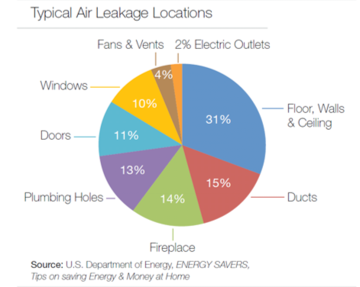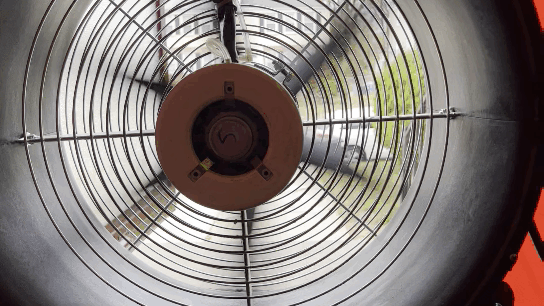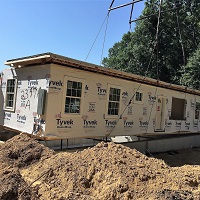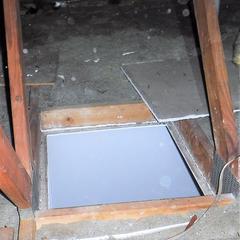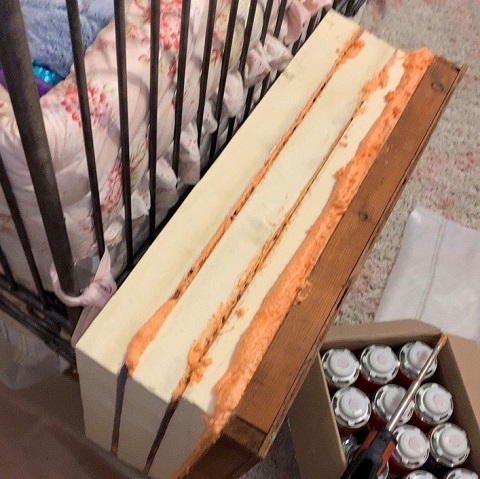Blower Door TestingWatch an explanation of the blower door test.
Blower Door Testing MarylandAir barriers throughout a house are tested during a blower door test and it is not uncommon for many of them to fail. The higher the measurement of the airflow the sensor in the blower door fan reads, the larger the leakage area around the house.
Additional diagnostic tests can be performed with the blower door to help isolate the worst leakage points so air sealing can be targeted and results driven. Once the test is running and the sensor is connected to the meter for pressure and air flow readings, it is best to walk around the home and perform a physical inspection to find air leakage places and determine the most effective treatment for the problem. It is really amazing to see where all of these leakage points occur and often times it is right in plain sight. A blower door test could help uncover four or five DIY solutions that will save hundreds over the course of time and could literally be the difference between a drafty house and and comfortable home. Blower Door Demo5 Reasons to Get a Blower Door Test in Maryland
A blower door test is a great way to isolate problem areas of the home as it relates to communication with the outside. One example would be to isolate an area of the home that is causing an issue. If there is an upstairs bedroom that seems particularly warm in summer, a blower door test may reveal that the room is connected to the outside. It could be through an un-caulked window molding, or a light fixure. A blower door test can help guide us to the issue. If the room is not connected to the outside, maybe the duct that supplies heating and cooling is disconnected or un-insulated. A blower door test helps eliminate issues in order to find the root cause of the comfort problem. 2. Confirm Window & Door Theories If I had a nickel for every audit I have done where the homeowner is in a debate with their spouse/partner about where the drafts are coming from. In some cases, both are convinced that the drafts are from the windows. An air leakage test using a blower door is the best way to prove or disprove any theory about how leaky the windows are in the house. Using odorless smoke pens and toy smoke makers, drafts in windows and doors can easily be uncovered with the use of a blower door test. Even the smallest of leak can be detected and determination about new windows can be made from the position of confirmed information. 3. Seeing Air Leak Into Your House is Empowering! There are several places around your home that you will be shocked to learn are leaky and don't just take our word for it! We will whip around your home during the blower door test and watch and feel the air stream in. There are places in the basement, in the ceiling and in the walls. The other side of the coin is the places where you won't find any leakage. That is equally important and should have an impact on feeling in control!
4. Uncover Leakage Points that are Hiding in Plain Sight Each and every day we go into our favorite bathroom and we spend some quality time. Those of us that are considerate flip on the exhaust fan and let it run for the duration. Have you ever gone into that bathroom on a cold winter morning and felt a temperature difference below the fan? Ever wonder why? An air leakage test will expose the bath fan as an offender - a secret gateway to the attic - where cold and hot air reign supreme. 5. Compare Your House to Similar Size Houses When you have a blower door test done with an experienced building analyst, you will receive feedback about the results of your air leakage test compared to those of similar sized houses. Although no two houses are exactly the same, fair and reasonable comparisons can be made based on the age and style of the home compared to others in Maryland. Knowing how your house compares to your neighbor is a good way to set goals and aspire for change with examples of success to model after.
Blower Door Tests Reveal Air LeakageA classic benefit of a blower door test is getting great results from thermal imaging while the blower door is in test mode and the leaky spots have air (hot or cold, depending on the time of year) streaming in from the outside. In this thermal imaging pair, the standard image shows the recessed light above the shower as the point of focus to determine if there is a thermal bypass in that location. One way, of course, to determine if it is leaky is to put your hand up and do a physical inspection. If the area is hard to reach, such as this light fixture, thermal imaging can reveal how much of a connection there is by the amount of cold or warm air that is detected by the camera. Blower Door Setup in 2.5 Min |
 The blower door is set up at the doorway and depressurizes the house (pulls the air out) and as a result gaps, cracks, holes, penetrations and several other culprits allow air to stream in! |  Reference photo of shower recessed light. What to expect during a blower door test A common question that is asked when a person sees the blower door for the first time is whether or not they need to leave the house during the test. The answer is no. One key to understanding how the blower door works is to take this misconception by many and show why it is not a dangerous test in any way. Thinking about pressure a little bit in terms of hamburgers might help. When the depressurization of the house reaches -50 pascals (a way to finely measure pressure) the result is recorded for the test. To give some perspective, the weight of one pascal is about 1/4 lb. So, the test has the equivalency of around 12.5 lbs. of pressure and all of the pressure is focused at the fan. The air that is running through the house after hitting -50 pascals is coming from the outside - through the house - and back out through the fan. To put that in perspective, if the house were air-tight and the blower door was running, the air would evacuate and there would be nothing left to breath. While the blower door is running it is a great time to walk around and determine how connected the house is to the outside at key locations around the thermal and pressure boundary of the home (envelope). |
Blower Door Testing Equipment and How it is Used Blower door test equipment set up and ready to depressurize this Maryland home. The blower door test is a Model 3 110V System fan that is suspended in the front door by a frame that is designed to be portable so it can be assembled in any home. The fan pulls air from inside of the house to the outside creating negative pressure. During the process of making the house go negative, the sensor reads the amount of air flowing through once the pressure reaches the desired goal.
A blower door is in fact a large, industrial strength fan, that has several components that make it much more than simply a fan. A special sensor and several pressure input pins allow for configurations to perform a multitude of testing procedures and diagnostics. A blower door is not an inexpensive piece of equipment and it must be calibrated per the manufacturer's specifications. Field calibrations keep the fan running well and they are quite durable and heavy!
The pressure and flow gauge is the hub of the blower door test and pulls the data from the pressure tubes and interprets the information into measurable results. A manometer, the formal name for the gauge, is a tool that can also be used to discover areas of the home that may be more connected to the outside than other areas of the home. Other interesting tests can be performed such as the hole to zone test where a pressure gauge can actually provide information with the blower door running to determine fairly accurate data about how large the hole is to the zone expressed cumulatively. In other words, it provides an easy to understand measurement in square inches how large the hole is to the outside zone (an attic for example) without having to measure every single tine crack and crevice. Here are the Best Ways to Do Very Well on a Blower Door Test
When it comes to sealing up a pre-existing home (retrofit) it is important to note that not every measure on this list is ideal based on a cost vs. value analysis, however it is important to note that when building a new home, building an addition or simply doing remodeling around the home it is super important to be familiar with each of these items because they are all great opportunities to decrease energy use and increase comfort. 1. Air barrier and thermal barrier.
2. Ceiling/attic
The attic hatch is a classic pressure and thermal bypass which requires treatment. 3. Walls
4. Windows, skylight and doors
5. Rim Joists
6. Insulation must be installed and affixed to the underside of the subfloor plywood.
7. Crawl Space Walls
8. Shafts, penetrations
9. Narrow Cavities
10. Garage Separation
11. Recessed Lighting
12. Plumbing and wiring
13. Shower/tub on exterior wall
14. Electrical/phone box on exterior walls
15. HVAC duct measures
16. Fireplace
Blower Door Testing in Maryland |



